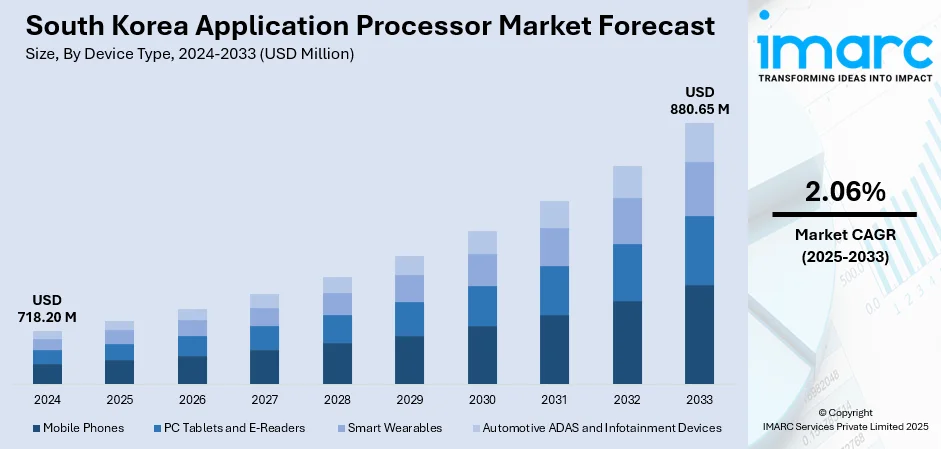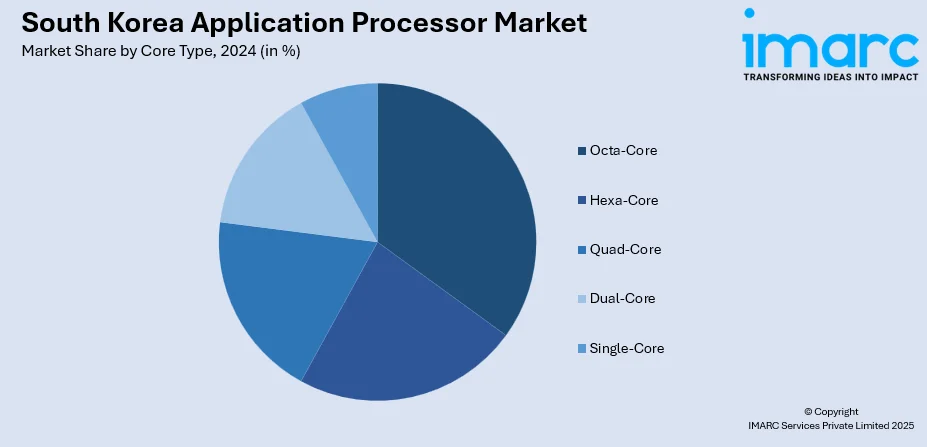
South Korea Application Processor Market Size, Share, Trends and Forecast by Device Type, Core Type, and Region, 2025-2033
South Korea Application Processor Market Overview:
The South Korea application processor market size reached USD 718.20 Million in 2024. Looking forward, IMARC Group expects the market to reach USD 880.65 Million by 2033, exhibiting a growth rate (CAGR) of 2.06% during 2025-2033. The heightened demand for mobile phones is fueling the growth of the market in South Korea. Moreover, with artificial intelligence (AI) and machine learning (ML) becoming an integral part of several electronic devices, such as smartphones, autonomous cars, and smart home devices, the demand for efficient processors with customized processing capabilities is growing. Apart from this, the transition to 5G connectivity is expanding the South Korea application processor market share.
|
Report Attribute
|
Key Statistics
|
|---|---|
|
Base Year
|
2024
|
|
Forecast Years
|
2025-2033
|
|
Historical Years
|
2019-2024
|
| Market Size in 2024 | USD 718.20 Million |
| Market Forecast in 2033 | USD 880.65 Million |
| Market Growth Rate 2025-2033 | 2.06% |
South Korea Application Processor Market Trends:
Growing Need for Mobile Devices
The heightened demand for mobile phones is fueling the South Korean application processor industry. With mobile technology progressing at a fast pace, people are always looking for smartphones with enhanced capabilities, such as increased gaming performance, the integration of artificial intelligence (AI), and better multimedia capability. South Korean players are spearheading this change, introducing fresh models featuring increased performance needs, thereby increasing the demand for more powerful and efficient application processors. These application processors are becoming optimized for carrying more data and delivering better user experiences. Also, the deployment of 5G networks is accelerating this trend, as smartphones become increasingly dependent on fast broadband to enable real-time applications. The need for smartphone processors that are capable of handling the heavier load of apps, AI-based applications, and high definition (HD) content is increasing, thereby contributing to the South Korea application processor market growth.

To get more information on this market, Request Sample
Developments in Artificial Intelligence and Machine Learning
Progresses in AI and machine learning (ML) are playing a key role in bolstering the market growth in South Korea. With AI and ML becoming an integral part of several electronic devices, such as smartphones, autonomous cars, and smart home devices, the demand for application processors with customized processing capabilities is growing. Application processors are being made to handle sophisticated AI algorithms and big data in real time efficiently. South Korean firms are increasingly embedding AI processing power directly into their application processors to enhance efficiency and functionality. These processors are facilitating quicker recognition, prediction, and data analysis, making products based on AI more accessible and efficient. With AI technologies taking center stage in consumer electronics, the South Korean market is quickly evolving, spending generously on research and development (R&D) to develop processors that are ML and deep learning optimized, thereby driving the demand for sophisticated processors overall. In 2025, South Korea declared its plans to sanction 10,000 high-performance graphics processing units (GPUs) to keep pace as the global AI competition rate increases. The government intends to obtain 10,000 GPUs via public-private partnerships to assist the nation in initiating facilities at its national AI computing center promptly.
Shift Toward 5G Connectivity and Internet of Things (IoT) Expansion
The transition to 5G connectivity and growth of the Internet of Things (IoT) are driving the need for application processors in South Korea. With 5G networks being deployed and providing greater data speeds and low-latency communication, devices need increasingly powerful processors to manage increased data traffic and provide real-time, seamless performance. South Korean makers are working to create application processors that are specifically designed to handle 5G applications as well as support smooth connectivity on a variety of devices. Concurrently, expansion in the IoT ecosystem is rising the number of connected devices, which require efficient processing power to deal with and analyze the resultant data. The requirement for application processors to manage the sophistication of 5G and IoT technologies is increasing as more devices become networked. According to a report from the Korean government, the 5G transmission speeds of South Korea’s top three mobile carriers increased by an average of 9.2% in 2024 compared to the previous year, greatly improving the quality of 5G services.
South Korea Application Processor Market Segmentation:
IMARC Group provides an analysis of the key trends in each segment of the market, along with forecasts at the country and regional levels for 2025-2033. Our report has categorized the market based on device type and core type.
Device Type Insights:
- Mobile Phones
- PC Tablets and E-Readers
- Smart Wearables
- Automotive ADAS and Infotainment Devices
The report has provided a detailed breakup and analysis of the market based on the device type. This includes mobile phones, PC tablets and E-readers, smart wearables, and automotive ADAS and infotainment devices.
Core Type Insights:

- Octa-Core
- Hexa-Core
- Quad-Core
- Dual-Core
- Single-Core
A detailed breakup and analysis of the market based on the core type have also been provided in the report. This includes octa-core, hexa-core, quad-core, dual-core, and single-core.
Regional Insights:
- Seoul Capital Area
- Yeongnam (Southeastern Region)
- Honam (Southwestern Region)
- Hoseo (Central Region)
- Others
The report has also provided a comprehensive analysis of all the major regional markets, which include Seoul Capital Area, Yeongnam (Southeastern Region), Honam (Southwestern Region), Hoseo (Central Region), and others.
Competitive Landscape:
The market research report has also provided a comprehensive analysis of the competitive landscape. Competitive analysis such as market structure, key player positioning, top winning strategies, competitive dashboard, and company evaluation quadrant has been covered in the report. Also, detailed profiles of all major companies have been provided.
South Korea Application Processor Market Report Coverage:
| Report Features | Details |
|---|---|
| Base Year of the Analysis | 2024 |
| Historical Period | 2019-2024 |
| Forecast Period | 2025-2033 |
| Units | Million USD |
| Scope of the Report |
Exploration of Historical Trends and Market Outlook, Industry Catalysts and Challenges, Segment-Wise Historical and Future Market Assessment:
|
| Device Types Covered | Mobile Phones, PC Tablets and E-Readers, Smart Wearables, Automotive ADAS and Infotainment Devices |
| Core Types Covered | Octa-Core, Hexa-Core, Quad-Core, Dual-Core, Single-Core |
| Regions Covered | Seoul Capital Area, Yeongnam (Southeastern Region), Honam (Southwestern Region), Hoseo (Central Region), Others |
| Customization Scope | 10% Free Customization |
| Post-Sale Analyst Support | 10-12 Weeks |
| Delivery Format | PDF and Excel through Email (We can also provide the editable version of the report in PPT/Word format on special request) |
Key Questions Answered in This Report:
- How has the South Korea application processor market performed so far and how will it perform in the coming years?
- What is the breakup of the South Korea application processor market on the basis of device type?
- What is the breakup of the South Korea application processor market on the basis of core type?
- What is the breakup of the South Korea application processor market on the basis of region?
- What are the various stages in the value chain of the South Korea application processor market?
- What are the key driving factors and challenges in the South Korea application processor market?
- What is the structure of the South Korea application processor market and who are the key players?
- What is the degree of competition in the South Korea application processor market?
Key Benefits for Stakeholders:
- IMARC’s industry report offers a comprehensive quantitative analysis of various market segments, historical and current market trends, market forecasts, and dynamics of the South Korea application processor market from 2019-2033.
- The research report provides the latest information on the market drivers, challenges, and opportunities in the South Korea application processor market.
- Porter's five forces analysis assist stakeholders in assessing the impact of new entrants, competitive rivalry, supplier power, buyer power, and the threat of substitution. It helps stakeholders to analyze the level of competition within the South Korea application processor industry and its attractiveness.
- Competitive landscape allows stakeholders to understand their competitive environment and provides an insight into the current positions of key players in the market.
Need more help?
- Speak to our experienced analysts for insights on the current market scenarios.
- Include additional segments and countries to customize the report as per your requirement.
- Gain an unparalleled competitive advantage in your domain by understanding how to utilize the report and positively impacting your operations and revenue.
- For further assistance, please connect with our analysts.
 Request Customization
Request Customization
 Speak to an Analyst
Speak to an Analyst
 Request Brochure
Request Brochure
 Inquire Before Buying
Inquire Before Buying




.webp)




.webp)












